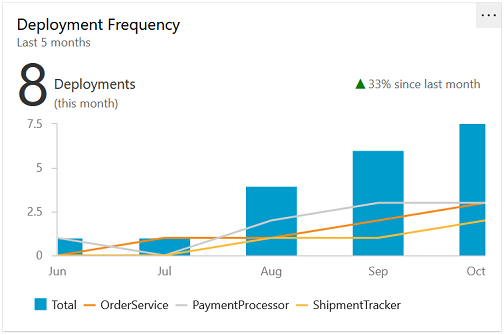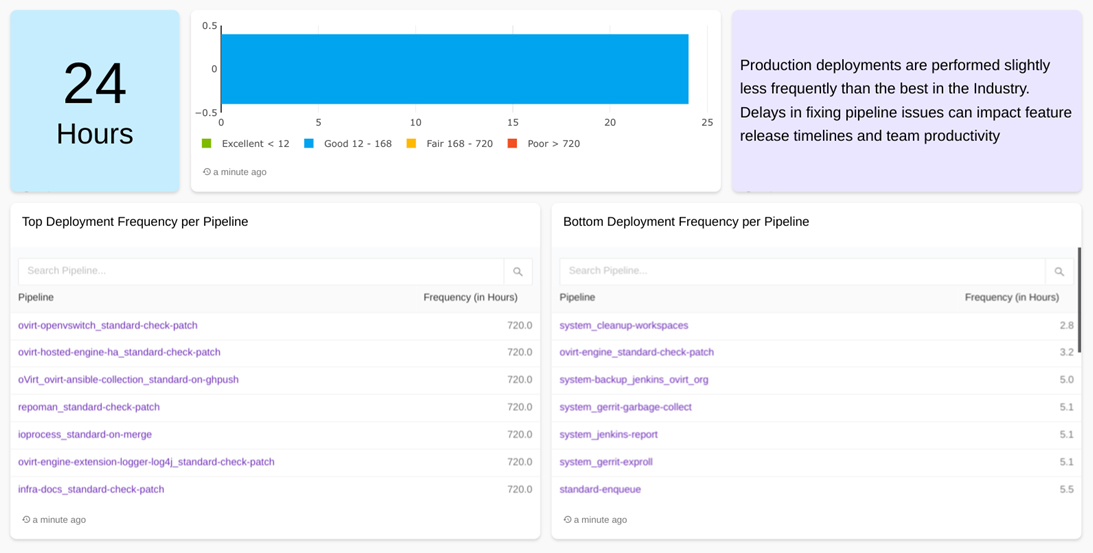
Figure : Azure DevOps extension
What is deployment frequency?
Deployment frequency is a key metric in DevOps. In layman’s terms, deployment frequency measures how often code is deployed to production. It ensures that software is delivered early and often. This metric is closely related to the speed and quality of a company’s engineering team. It can be a very good indicator of team response time, cohesiveness, capabilities and overall efficiency.
Today’s companies are evolving and improving products quicker than those that solely rely on traditional software development and infrastructure management processes.
How often does it need to be measured?
Deployment frequency varies from organization to organization. It can be anywhere from bi-yearly, monthly, or weekly, to several times a day. It depends on the organization’s goals and what services it offers.
A common misconception is that shipping code to production regularly
involves more risk. This is not true. The smaller the batch size, the better it is.
When changes are small in scope, it is easier to fix when something goes wrong. Those changes are easily understood. This puts less overall risk on the developer end and on the company too.
Several companies shift to production in fixed intervals throughout the day. This is good practice. When DevOps is integrated into a company’s work culture, the deployment rate will either stay constant or gradually increase. This metric has a direct correlation with continuous delivery. It can also measure the comprehensive use of version control, thus offering managers a peek into the efficacy of strategies within an organization.
The deployment frequency metric is central to the heart of DevOps. The idea of continuous delivery and shipping code as fast, small, and frequent deployments is a beautiful one. When code sent to production has lesser changes, it is much easier to test and release code.
When this metric is low, it means there are broader issues for the company, for example there might not be so well developed processes and teams. A high deployment frequency means that teams are highly agile, quick in providing value and reacting to feedback and changes.
How to increase deployment frequency?
- Implementing CI/CD best practices: This will increase your software delivery speed. CI/CD is an abbreviation for Continuous Integration/Continuous Delivery.
- Work on small and self-contained changes: Smaller changes means smaller fixes if something glitches during runtime.
- Work on reducing your technical debt:
- Use test automation: incorporate automated tests at every stage of the CI/CD pipeline so bugs can be identified and corrected sooner.
- Automate code reviews: this can improve your code quality and save your team valuable time.
- Use release trains if you are working on larger monoliths: multiple changes are batched together, coordinating changes to be released at the same time.
Calculation methods
CI/CD tools such as Jenkins, and CircleCI are required to show data. Typically this is done through reporting plug-ins to such tools or via end-to-end delivery metrics dashboard such as Plandek.
Analysis
Delivery metric dashboards like Plandek enable users to analyze delivery, engineering, and DevOps in a number of different ways. This way, set targets can be achieved and practical actions can be taken to increase deployment frequency.
Deployment frequency is a key DevOps metric used to ensure that software is delivered early and often. Much time is devoted to tracking and improving development-oriented metrics (i.e. cycle time, throughput). The acid test tells us that software developed by the engineering team is regularly deployed to live….otherwise all effort is wasted. By and large, it is true but in some organizations, the software they develop may be thrown away at the last minute; in other words, they don’t deploy but have some learnings. Therefore deployment frequency is not only a key DevOps metric but also a critical broader Agile delivery metric.
Conclusion
The deployment frequency metric offers much insight into team workflow and is the key to establishing data-driven goals which will give way to improvements in DevOps. Along with lead time for changes, time to recover, and change failure rate, successful interpretation can help the company achieve maximum engineering performance.
Kaiburr’s AI engine captures the Deployment Frequency data in real-time and showcases it quite beautifully for Leaders to make well informed decisions.

Kaiburr helps software teams to measure and benchmark themselves on 350+ KPIs and 600+ Best Practices so they can continuously improve every day.
Reach us at contact@kaiburr.com to get started with metrics driven continuous improvement in your organization.
